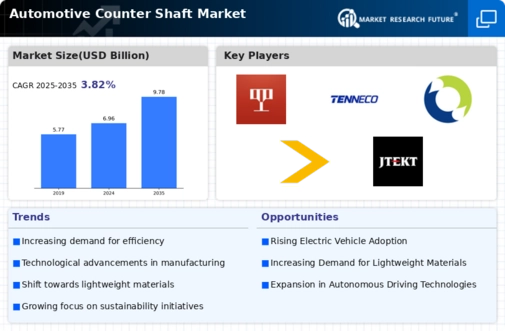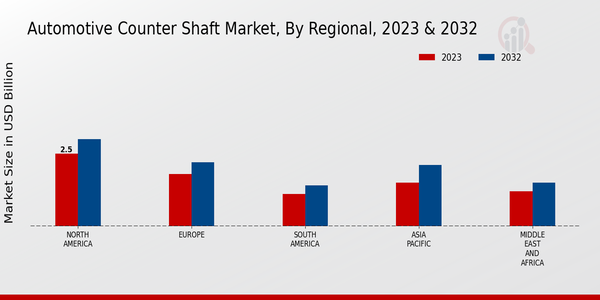Market Trends and Projections
Growing Demand for Fuel Efficiency
The Global Automotive Counter Shaft Market Industry is witnessing an increasing demand for fuel-efficient vehicles, driven by rising fuel prices and environmental concerns. Automotive manufacturers are focusing on enhancing the efficiency of their powertrains, which directly influences the design and functionality of counter shafts. As a result, the market is projected to reach 6.96 USD Billion in 2024, reflecting the industry's commitment to sustainability. The integration of advanced materials and manufacturing techniques in counter shaft production contributes to weight reduction and improved performance, aligning with global trends towards greener automotive solutions.
Increase in Vehicle Production and Sales
The Global Automotive Counter Shaft Market Industry is significantly influenced by the rising production and sales of vehicles worldwide. As emerging economies continue to expand their automotive sectors, the demand for counter shafts is expected to surge. The market is anticipated to reach 9.78 USD Billion by 2035, driven by the increasing number of vehicles on the road. This trend is further supported by government initiatives promoting vehicle ownership and infrastructure development, which collectively bolster the automotive supply chain and, consequently, the demand for essential components like counter shafts.
Shift Towards Electric and Hybrid Vehicles
The shift towards electric and hybrid vehicles is reshaping the Global Automotive Counter Shaft Market Industry. As consumers increasingly favor eco-friendly transportation options, automotive manufacturers are adapting their designs to accommodate electric drivetrains. This transition necessitates the development of specialized counter shafts that can handle unique torque and power requirements. Consequently, the market is poised for growth, as manufacturers invest in the production of counter shafts tailored for electric and hybrid applications, ensuring compatibility with the evolving automotive landscape.
Regulatory Compliance and Emission Standards
Regulatory compliance and stringent emission standards are critical drivers in the Global Automotive Counter Shaft Market Industry. Governments worldwide are implementing regulations aimed at reducing vehicular emissions, compelling manufacturers to innovate and enhance their products. Counter shafts, being integral to the powertrain, must meet these evolving standards, which often involves adopting advanced technologies and materials. This regulatory landscape not only fosters innovation but also ensures that the automotive industry aligns with global sustainability goals, thereby influencing the demand for high-performance counter shafts that comply with these regulations.
Technological Advancements in Automotive Engineering
Technological innovations in automotive engineering play a pivotal role in shaping the Global Automotive Counter Shaft Market Industry. The advent of electric and hybrid vehicles necessitates the development of specialized counter shafts that can withstand different operational conditions. As manufacturers invest in research and development, the market is expected to grow at a CAGR of 3.14% from 2025 to 2035. This growth is indicative of the industry's adaptation to new technologies, such as lightweight materials and precision manufacturing processes, which enhance the durability and efficiency of counter shafts in modern vehicles.
















